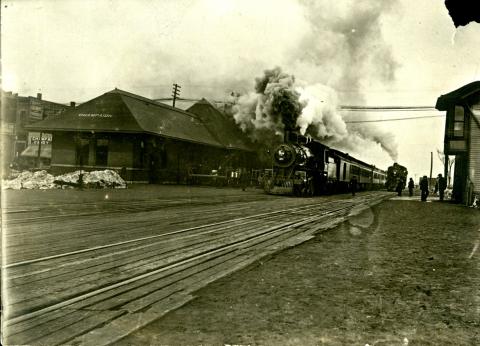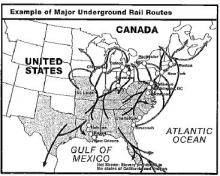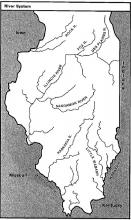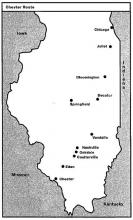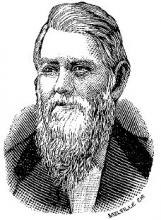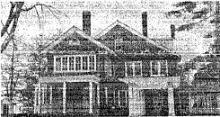Central Illinois history is often intertwined with that of railroad history. The city of Champaign, along with several other Champaign County towns and villages, were formed when the Illinois Central Railroad line was constructed in the 1850s. But, what about the secret railroad network without trains or tracks that existed in the 19th century? Before the abolition of slavery in America, the Underground Railroad was a network of safe routes and houses in the United States and Canada used by African-American freedom seekers and allies to help enslaved individuals escape to free states, and sometimes to flee the country. Abolitionists and other individuals with anti-slavery sentiments provided Underground Railroad “passengers” with food, shelter, and guidance to other “stations.”

Though Illinois was a free state, many federal and state laws made assisting fugitives of slavery a punishable offence, even in northern states. These include Article 4, Section 2, Clause 3 of the United States Constitution, the 1793 Fugitive Slave Law, and the Fugitive Slave Act of 1850. Northern states also passed personal liberty laws and anti-kidnapping acts to try and counteract the runaway laws imposed, and much more strictly enforced, in the south. The legalities and possible penalties involved led to the creation of the secretive Underground Railroad.
Although activity was most highly concentrated along the east coast, a few well-established Underground Railroad routes traversed the state of Illinois. Most of these routes were along the Mississippi River coming from the slave state of Missouri. Other routes provided passage from Kentucky and Tennessee to the terminus city of Chicago. Important waterways in and around Illinois included the Mississippi River, Missouri River, Cumberland River, Ohio River, and the Illinois and Michigan Canal. None of these routes passed through Champaign County, though.
So is there a Champaign County connection to Underground Railroad efforts? Were there documented depots and conductors in the area? The answer is…sort of. While there is not an official Underground Railroad depot that has been identified and documented by historical sources in Champaign County, rumors abound.
The most widely speculated stories revolve around Mathias Dunlap, a prominent early resident of Champaign County. It is said that Dunlap used his home in what is now the village of Savoy as a "depot" in the Underground Railroad. This information is mentioned in The Historical Encyclopedia of Illinois, Vol. 1 by Newton Bateman and Paul Selby, page 142.
Dunlap (1814-1875) was politically active all of his life and was a well-known writer and editor. He served as a founding member of the Illinois Industrial University (now the University of Illinois at Urbana-Champaign) board of trustees, and lived in Champaign County from 1857-1875. According to a biographical sketch in A Biographical History of Western Star Lodge No. 240 A.F. & A.M., “Dunlap was strongly opposed to the issue of slavery. His home became one of the ‘depots’ of the Underground Railroad, assisting those former slaves escaping from the South.” In her book, Chicago’s Mr. Rural…, Gretchen Rauschenburg states, “The M.L. Dunlap home at Dunlap’s Prairie was part of the Underground Railway, helping southern slaves escape to Canada. After he moved to Champaign County in 1858, his new home there also became a refuge of slaves on their way north.” Again, Dunlap's abolitionist ties are expounded upon in Rauschenberg’s book: “In the mid-1850s M.L. had been active as an Anti-Nebraska Democrat, against the expansion of slave states. The Dunlaps had sheltered escaping slaves in their home at Dunlap’s Prairie, and continued to open their doors to such travelers after moving to Champaign County. The big house with its ramp into the basement often provided shelter to those headed north to Canada. The basement rooms offered endless places to hide during the day.”
Some colloquial remembrances state that The Senator's Inn & Pub in Savoy, Ill. was a stop on the Underground Railroad, but it was built as a residence by Dunlap's son, Henry M. Dunlap, in 1915, so the dates do not match. The book The Underground Railroad in Illinois by Glennette Tilley Turner has some interesting insights into Illinois routes and explains why only the best known routes were documented. At a time when individuals could be prosecuted and sentenced to serve time in prison, or to pay heavy fines, or even risked their lives to help freedom seekers escape, secrecy was everything.
Selected bibliography:
A Biographical History of Western Star Lodge No. 240 A.F. & A.M., by David W. Godwin, 1998, p. 112
Chicago’s Mr. Rural: The Life of Mathias Lane Dunlap Columnistin the Press and the Tribune, by Gretchen S. Rauschenberg, 2007, p. 101 and 146.
Early History and Pioneers of Champaign County, by Milton W. Mathews, 1891, p. 96
Sketch of Senator’s Inn found in the Vertical file for Senator's Inn and Pub located at the Champaign County Historical Archives.
Champaign County Historical Archives books that include information on the Underground Railroad and its Illinois connections:
His Promised Land: the autobiography of John P. Parker, former slave and conductor on the underground railroad by John P. Parker, 1996.
Illinois Negro Historymakers, Carl G. Hodges, 1964
Negro Servitude in Illinois, N. Dwight Harris, 1904
New Philadelphia by Gerald A. McWorter, 2018
The Underground Railroad in Dupage County, Illinois by Glennette Tilley Turner, 1978
The Underground Railroad in Illinois by Glennette Tilley Turner, 2001
The Underground Railroad in Western Illinois by Owen W. Muelder, 2008
For more information about the Underground Railroad:
The US National Park Service has compiled a list of Underground Railroad sites in the United States.
Illinois Farm Bureau Partners has a blog post about the Underground Railroad in Illinois.
- Donica M.
Archives Librarian
This blog post was inspired by a reference question we received in the Archives. Do you have a question to ask an Archivist? Let us know.

